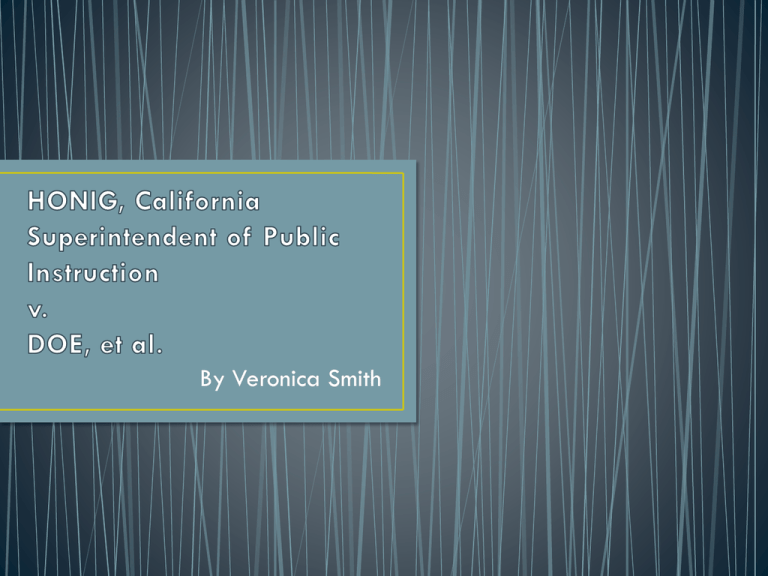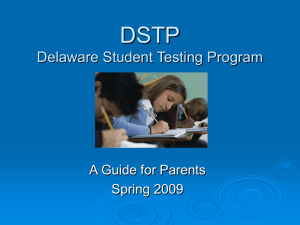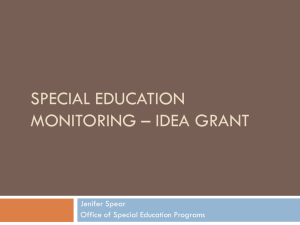HONIG, California Superintendent of Public Instruction v. DOE, et al.
advertisement

By Veronica Smith • Enacted in 1975 • All schools receiving federal funds must provide equal access to education as well as one meal a day to all children with disabilities • School districts required to create a system where parents could argue a school’s decision • All student’s must be in least restrictive environment • Before enactment, 1 out of 8 handicapped children were not in school and many more were in classrooms that did not provide well for their education • EAHCA underwent revision and was renamed IDEA in 1990. The stay put clause from EAHCA is also included in IDEA • Just less than 1% of school children are being served under IDEA for an emotional disorder. A 2005 study suggests that just over 20% of children in school could qualify for a psychiatric diagnosis. • Many students not receiving adequate services • 9% of children receiving special education services fall in the category of emotionally disturbed- 80% of these are boys • When looking at all 50 states, the emotionally disturbed category shows the most variance in prevalence rates • From a 2010 study using 397 emotionally disturbed children: • Boys who have been physically abused are 50% more likely to show reactively aggressive behavior- unrelated in girls • Ethnic minority children who have been physically abused are at risk for reactive aggressive behaviors- especially younger children • Physically abused boys with emotional disturbances are at high risk for reactive aggression while proactive aggression was not related. • 2002 study with 25 boys with emotionally disturbances and control group of 22 • Two groups did not differ in nonverbal skills • Only within the emotionally disturbed group were the boys with more errors in recognizing facial expressions or decoding emotion in voices more likely to hit or push • Errors in decoding child voices correlated to teasing others • Teachers did not see a difference in how often others play with a child based on their ability to identify emotions in faces or voices • To qualify for services under an emotional disability a student must meet the following: • (a) an inability to learn that cannot be explained by intellectual, sensory, or health factors • (b) an inability to build or maintain satisfactory interpersonal relationships with peers or teachers • (c) inappropriate types of behaviors or feelings under normal circumstances; • (d) a general pervasive mood of unhappiness or depression • (e) a tendency to develop physical symptoms or fears associated with personal or school problems. • This category includes children with schizophrenia but excludes those who are “socially maladjusted” • The above must be consistent over time and interfere with the child’s ability to participate in the school environment • DSM also requires symptoms be seen over a length of time for diagnosis for conditions such as conduct disorder, major depressive disorder, and generalized anxiety disorder. • First case to reach Supreme Court pertaining to suspension and expulsion of emotionally disturbed children • Originally known as Doe v Maher when first tried in October of 1986. Renamed Honig v Doe in November of 1987 when case was appealed to Supreme Court. • Honig was the California Superintendent of Instruction • Doe and Smith are fictional names given to ensure the privacy of children involved in the case • Case was filed by California Superintendent, Honig, who was seeking the court’s support to remove children with severe emotional and behavioral disorders from school. • November of 1980 John Doe, 17 years old, assaulted another student in his school for students with developmental delays. • His IEP from April of 1980 noted his physically and socially awkward behavior, low tolerance for frustration, anger management issues, and impulsiveness. IEP also stated that his social skills, as well as his ability to deal with frustration, had been declining. • John Doe’s physical and speech delays, along with poor grooming habits had made him the subject of teasing throughout his school years • November 6, 1980 • As a direct reaction of teasing from another student, Doe began to choke the other child and left marks on his neck • While being taken to the principals office, Doe kicked out a window. • Doe admitted that his actions had been wrong and was suspended for 5 days • Student Placement Committee (SPC) let the mother know that her son had been recommended for expulsion from school. • On the final day of the original 5 day suspension the school notified the mother that the suspension was being extended until the expulsion proceedings could be completed • Mother was invited to attend the hearing on November 25th • John Doe’s family protested school’s decision in writing • When school would not relent, Doe’s mother sought legal counsel and brought suit against the local school officials and state superintendent. • Judge ruled that the expulsion violated John Doe’s right to a free and appropriate public education • SPC hearing was cancelled and school was required to hold an IEP meeting • School also required to provide tutoring at home • Just after, the judge ordered the school to allow Doe to return to his original school • Doe missed 5 ½ weeks of school • School had in records • • • • • • • • • • Identified as emotionally disturbed in second grade in 1976 Had trouble controlling verbal and physical outbursts Very poor relationships with peers and adults Physically and emotionally abused as a young child Above average intelligence Hyperactivity Low self-esteem Verbal hostility Academic and social difficulties Placed in learning center for emotionally disturbed • Grandparents felt that Jack would receive a better education in a public middle school and the school agreed to meet their request • September, 1979- Jack began public middle school on half-day enrollment • IEP made provision for Jack to be in a learning disability group and emphasized the structure and supervision for placement to be successful • Jack was moved to full-day placement for following academic year • Behavior began to decline once in school full-day. School met with grandparents and let them know that Jack’s day would be reduced back to half days if his poor behavior continued. This behavior included stealing, extorting money from students, and making sexual comments. • On November 14th, Smith was expelled after making sexual comments to another student • SPC committee recommended expulsion • SPC scheduled hearing for expulsion and increased suspension to date of hearing • Smith’s family sought legal counsel and SPC cancelled meeting and allowed Smith to either return to school half-day or receive home-based services • Home-based tutoring was started on December 10th. • On January 6th, Smith’s IEP team met to explore alternative placement options • Smith heard of Doe’s case and decided to intervene • Claimed that suspensions violated right to free and appropriate education and rights as set out in EAHCA • District Judge ruled • No disciplinary action taken against students for behavior resulting as a manifestation of disability with exception of 2 and 5 day suspensions • No change in placement without parental consent until EHA proceedings complete • State not allowed to authorize unilateral placement changes • EAHCA compliance-monitoring system • Or guideline must be put in place regulating school response to disability manifestation misconduct • State must provide services to disabled children when local school is not able or willing • Court of Appeals for the Ninth Circuit • Court reaffirmed original rulings and made some minor revisions • Reaffirmed that indefinite suspension or expulsion is a change of placement • Stay-put provision has no exception clause for dangerous children and so this invalidated the California Education Code which allowed for indefinite suspension or expulsion for disabled children who were found to be dangerous or violent behaviors as a result of their disability • Children may not be expelled or suspended for behavior related to disability • State required to provide educational services to disabled children when local public school unable or unwilling • Bill Honig, California Superintendent of Public Instruction disagreed with the decision made in Maher v Doe. • Honig argued that the court’s decision did not line up with the precedent set by other cases where a danger exception had been allowed. • Honig also claimed that requiring the state to provide education when a local school is unwilling or unable placed an intolerable burden on the state. • Honig argued that the original EAHCA was not to be taken literally when being applied to dangerous children as it would take away school’s ability to discipline these children- stated that Congress had not included this because it should be seen as common sense • When Honig filed his suit John Doe was 24 and so not eligible for any services. Jack was 20 and still completing his education, though he was living in another district. • The Supreme Court upheld the original ruling • Children must remain in their current placement while disciplinary proceedings are underway unless the school and the parents come to another agreement • Court did not acknowledge a “dangerousness exception” to the stayput clause of EAHCA • This is a change of placement. • No unilateral changes of placement • In response to Honig’s argument that EAHCA should not be taken literally for violent children the Court stated that Congress “very much meant to strip schools of the unilateral authority they had traditionally employed to exclude disabled students, particularly emotionally disturbed students, from schools.” • Schools may use detention, restriction of privileges or suspensions of up to 10 days. • If violent misconduct is determined to be unrelated to a child’s disability they do not have “stay put” rights. These children are subject to the same discipline as their peers and can be suspended or expelled • IDEA includes one exception to the 10 day suspension limit. Children who bring a weapon to school or who are found in possession of, takes, or solicits, or sells drugs can be expelled for up to 45 days. This does not require parental agreement. • • • • The student’s guardian can request an alternative placement for the 45 days IEP team is required to develop a behavior plan IEP team must complete a functional behavioral assessment Behavior plan must be implemented Bill honig, california superintendent of public instruction, petitioner v. john doe and jack smith. (n.d.). Retrieved from https://bulk.resource.org/courts.gov/c/US/484/484.US.305.86-728.html Cooley, E., Triemer, D., & , (2002). Classroom behavior and the ability to decode nonverbal cues in boys with severe emotional disturbance. 142(6), 741-751. Retrieved from http://web.ebscohost.com/ehost/pdfviewer/pdfviewer?sid=438d52c6-b30b-4996-9b285ede9fee1ccd@sessionmgr10&vid=2&hid=28 Cullinan, D., Epstein, M. (1986). Legal decisions and appropriate education of seriously emotionally disturbed (sed) students. The journal of special education, 20(2), 265-272. Retrieved from http://web.ebscohost.com/ehost/pdfviewer/pdfviewer?sid=b8d44bff-8c88-4279-94b39fb1ba0e98ab@sessionmgr4&vid=2&hid=15 Ford, J., Fraleigh, L., & Connor, D. (2010). Child abuse and aggression among seriously emotionally disturbed children . Journal of clinical child and adolescent psychology, 39(1), 25-34. Retrieved from http://web.ebscohost.com/ehost/pdfviewer/pdfviewer?sid=03ce6d4c-66c8-49a99b6a-fa3202d2f45c@sessionmgr114&vid=2&hid=104 Gresham, F. (2005). Response to intervention: An alternative means of identifying students as emotionally disturbed. Education and treatment of children, 28(4), 329-344. Retrieved from http://web.ebscohost.com/ehost/pdfviewer/pdfviewer?sid=56db5b3f-43e1-4136-8d25430ffb6dbe0d@sessionmgr104&vid=2&hid=110 Honig, california superintendent of public instruction v. doe, et al.. (2011, 02 14). Retrieved from http://www.wrightslaw.com/law/caselaw/ussupct.honig.doe.htm Jacob, S., Decker, D., & Hartshorne, T. (2011). Ethics and law for school psychologists. (6 ed.). Hoboken: John Wiley & Sons, Inc. Thompson, K. (1999). Limits on the ability to discipline disabled school children: Do the 1997 amendments to the idea go far enough?. Indiana law review, 32, 565-589. Retrieved from http://journals.iupui.edu/index.php/inlawrev/article/viewFile/3350/3281 Vasta, R., Miller, S., & Ellis, S. (2004). Child psychology. (4 ed.). Hoboken: John Wiley & Sons, Inc






